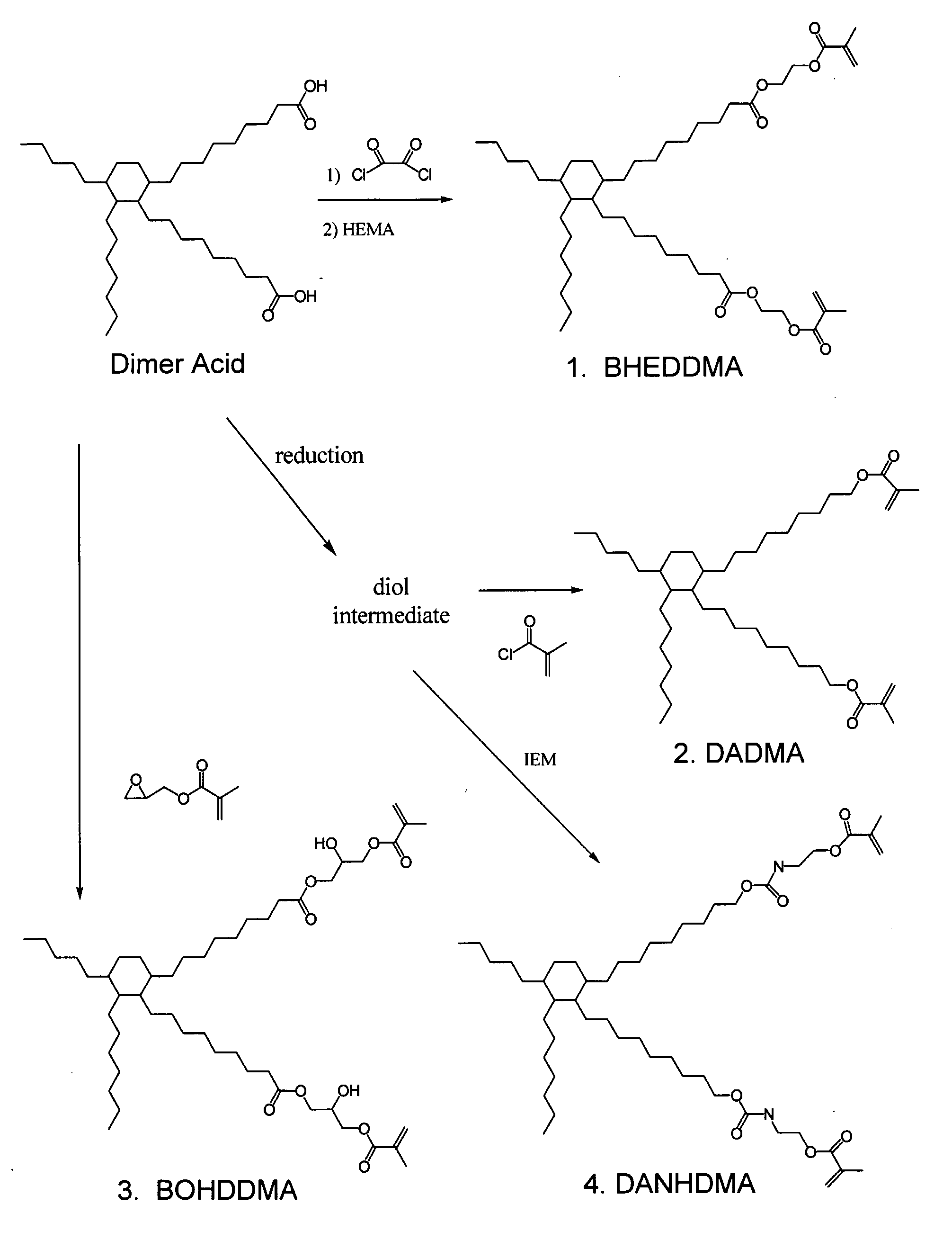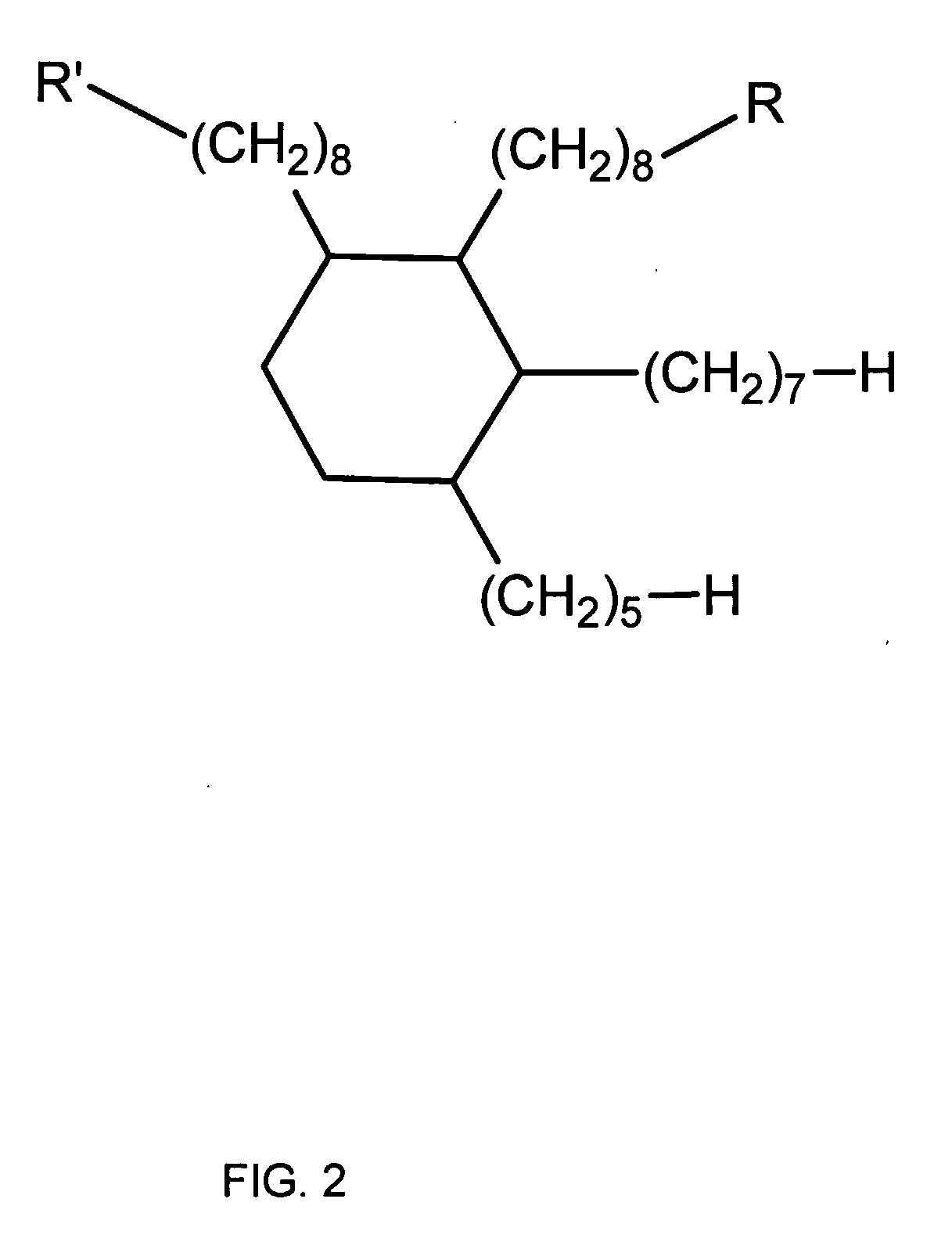Dimer Acid-Derived Dimethacrylates and Use in Dental Restorative Compositions
a technology of dimethacrylate and dimer acid, which is applied in the field of monomers, can solve the problems of limiting the clinical performance of existing dimethacrylate monomers and materials, excessive polymerization shrinkage, and limiting the clinical performance of dental restorative compositions, etc., and achieves the effects of reducing shrinkage, reducing odor, and increasing conversion
- Summary
- Abstract
- Description
- Claims
- Application Information
AI Technical Summary
Benefits of technology
Problems solved by technology
Method used
Image
Examples
example 1
Synthesis of Dimer Acid-Derived Monomers—General Methods
[0056]In preparation of dimer acid-derived monomers, a dimer acid hydrogentate was used as a starting material, and converted to the diol (1).
[0057]Ten (10) g (0.0177 mol) of dimer acid hydrogenate dissolved in 200 mL of ethyl ether was added slowly, at room temperature under nitrogen atmosphere to an excess of LiAlH4 suspended in 200 mL of ethyl ether. The reaction mixture was then refluxed for 1 hour and then stirred at room temperature over night. Two hundred (200) mL of cooled water was added carefully followed by addition of a 10% solution of sulfuric acid to neutralize the unreacted LiAlH4. The organic layer was separated and the aqueous layer washed three times with ether. The organic layers were collected and dried with Na2SO4. Finally, the solvent was evaporated to obtain 6.9039 g (73%) of colorless viscous oil. The IR, 1H NMR and 13C NMR were recorded.
[0058]IR (KBr, cm−1): ν 3327 (OH), 2926, 2854 (CHaliphatic)
[0059]1H...
example 2
Synthesis of DADMA
[0061]
[0062]1.6991 g (0.00316 mol) of diol (1) dissolved in 50 mL of methylene chloride and 0.6715 g (0.0066 mol; 2.1 eq) of triethyl amine were mixed under nitrogen atmosphere. 0.6615 g (0.00632 mol, 2 eq) of methacryloyl chloride in 20 mL of CH2Cl2 was added to the mixture drop-wise. The reaction was allowed to stir for 18 hours at room temperature. The reaction mixture was then treated with 1M solution of HCl (2×20 mL), a concentrated solution of NaHCO3 (2×20 mL) and finally with water (1×10 mL). The organic layer was dried with Na2SO4 and the solvent was evaporated to obtain a liquid in 60% yield.
[0063]IR (KBr, cm−1): ν 3105 (═CH2), 2925, 2854 (CHaliphatic), 1721 (CO), 1639 (═CH2)
[0064]1H NMR (500 MHz, CDCl3): δ 6.04, 5.48 (m, ═CH2), 4.09 (m, OCH2), 1.89 (s, CH3), 1.9-1.0 (m, CH and CH2), 0.83 (m, CH3).
[0065]13C {1H} NMR (125 MHz, CDCl3): δ 167.6 (CO), 136.7 (C═CH2), 125.2 (C═CH2), 64.9 (OCH2), from 38 to 20 (CH and CH2 aliphatic), 18.5 (CH3), 14.3 (CH3).
example 3
Synthesis of DANHDMA
[0066]
[0067]To a solution of 4.0623 g of diol (1) in 50 mL of CH2Cl2 and 1.6077 g (0.0589 mol, 2.1 eq) of NEt3, 2.3479 g (0.01513 mol, 2.0 eq) of isocyanate ethylmethacrylate was added drop-wise under nitrogen atmosphere at room temperature. The reaction mixture was stirred over night to warranty complete reaction. The reaction mixture was then treated with HCl (1M solution, 2×10 mL), NaHCO3 (saturated solution 2×0 mL) and water (1×10 mL). The organic layer was separated and dried with Na2SO4, filtered and purified by chromatographic column using a mixture CH2CL2: Ethyl acetate 80:20 to obtain 5.215 g (yield 82%) of colorless oil.
[0068]IR (KBr, cm−1): ν 3357 (NH), 3104 (═CH2), 2925, 2854 (CHaliphatic), 2270 (OCN), 1722 (CO), 1639 (═CH2)
[0069]1H NMR (500 MHz, CDCl3): δ 6.11, 5.57 (m, ═CH2), 4.99 (s-br, NH), 4.21, 4.03 (m, OCH2), 3.47 (NHCH2), 1.93 (s, CH3), 1.9-1.0 (m, CH and CH2), 0.87 (m, CH3).
[0070]13C {1H} NMR (125 MHz, CDCl3): δ 167.4, 156.9 (CO), 136.2 (C═CH...
PUM
| Property | Measurement | Unit |
|---|---|---|
| Percent by mass | aaaaa | aaaaa |
| Weight | aaaaa | aaaaa |
| Composition | aaaaa | aaaaa |
Abstract
Description
Claims
Application Information
 Login to View More
Login to View More - R&D
- Intellectual Property
- Life Sciences
- Materials
- Tech Scout
- Unparalleled Data Quality
- Higher Quality Content
- 60% Fewer Hallucinations
Browse by: Latest US Patents, China's latest patents, Technical Efficacy Thesaurus, Application Domain, Technology Topic, Popular Technical Reports.
© 2025 PatSnap. All rights reserved.Legal|Privacy policy|Modern Slavery Act Transparency Statement|Sitemap|About US| Contact US: help@patsnap.com



